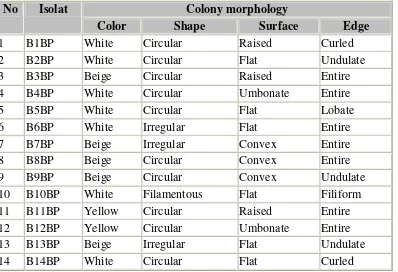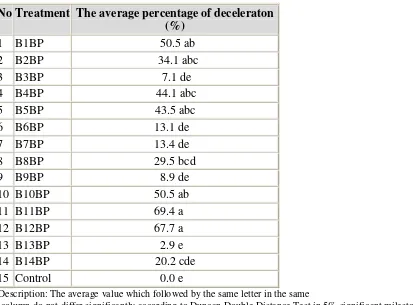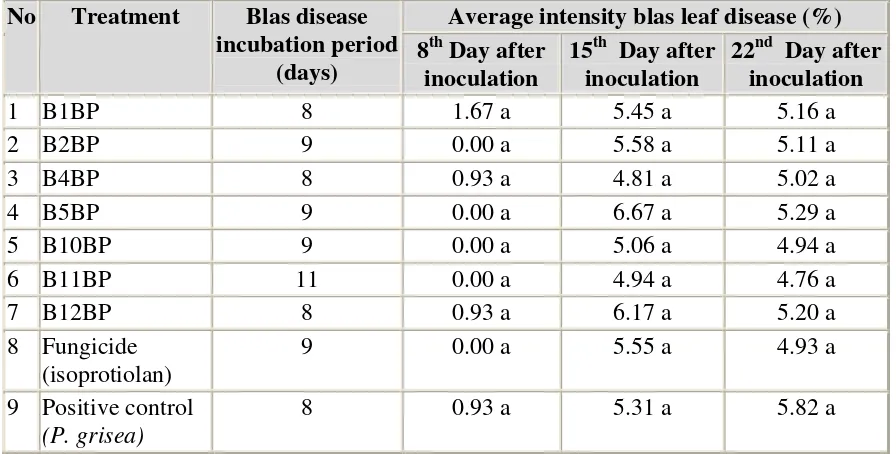Antagonistic Potency of Bacteria Isolated from Local Microorganism of Banana Stump in Suppressing Blast Disease (Pyricularia grisea [Cooke] Sacc) on Rice
Hersanti , Luciana Djaya and Mukhtar Hamim
Plant Pest and Disease Department, Agriculture Faculty, Universitas Padjadjaran
ABSTRACT
Blast disease caused by Pyricularia grisea [Cooke] Sacc. is the most important disease on dry land rice. The use of antagonistic bacteria as bio-control agents is an alternative control method and friendly to environment.
The objective of the research was to isolate bacteria from Local Microorganism (MOL) of bananastump which were antagonistic to P. grisea in vitro and able to suppress blast on dry land rice var Cirata in glasshouse. The research was carried out in the Phytopathology Laboratory and Glasshouse of the Department of Plant Pests and Diseases, Faculty of Agriculture, Universitas Padjadjaran from December 2008 to March 2009.
There were two experiments i.e.: dual culture test on potato dextrose agar (PDA) and antagonism test on dry land rice var Cirata in the glasshouse. Both treatments were arranged in the completely randomized design consisted of 4 replications for in vitro and 3 replications for glasshouse test.
Among the fourteen bacterial isolates tested by dual culture, 7 isolates were antagonistic against P. grisea in vitro. The highest suppression was shown by B11BP isolate, the in vitro inhibition was 69,4%. However, the seven bacterial isolates were not effective in suppressing blast on dry land rice var Cirata in the glasshouse.
Key Word : Bacteria, Microorganisme Local, Blast, Rice
INTRODUCTION
One of the constraint factors of rice production in the world is blas disease (Agrios, 1997; Koga, 2001). This disease has lowered the the world’s rice harvest around 50-90% (Agrios, 1997; Baker et al., 1997). Blas disease’s attacks could reach 12% of the total rice plantation area in Indonesia (Badan Pusat Statistik, 2004). Blas disease caused by the fungi Pyricularia grisea
[Cooke] Sacc. Pyricularia oryzae Cavara synonyms.; teleomorph Magnaporthe grisea [Hebert] Barr., are important pathogenic fungi on rice plants (Rossman et al., 1990 in Reflinur et al., 2006; Manandhar et al., 1998; Suparyono et al., 2003) .
intensification system does not require chemical fertilizers and other chemicals, but will use the materials available in nature.
MOL usage besides as fertilizer and decomposer in the SRI component technology, MOL is also used as a natural pesticide to control plant’s pest organisms (Anugrah, 2007; Ekamaida, 2008; Hersanti & DJAYA, 2008). Hersanti & Djaya research (2008) has been obtained 19 (Nineteen) isolated bacteria of different types of Mol which are from cebreng leaves’ Mol, shoots squash’s Mol, maja fruit’s MOL, bamboo sprout’s MOL, bananas’ Mol, banana tuber’s MOL. Test results of the dual culture of 19 (nineteen) isolated bacteria note 6 isolated bacteria have the antagonistic ability against fungus Rhizoctonia oryzae and 4 of isolated bacteria have the antagonistic ability against fungus Cercospora oryzae.
The availability of MOL raw materials needs to be put under consideration. The use of banana’s stumps as the primary raw material in making of MOL has a strategic value, as there are many banana plantations found in Indonesia. In Asia, including Indonesia as the largest producer of bananas around 50% of banana production comes from Asia, Indonesia became fourth largest bananas production countries in the world. Almost all part of Indonesia is a regional producer of bananas (Astawan, 2008). Information of MOL usage with bananas stumps as the main raw material is expected to be one of the alternative controls of plant diseases. Antagonist ability of the bacteria that come from to control blas diseases is not yet known. Therefore, the research of utilizing antagonist isolated bacteria from bananas stump’s Mol needs to be done, so it can be used as bio control agent in controlling the blas disease on rice.
RESEARCH METHOD
Research conducted in the Laboratorium Fitopatologi dan Rumah Kaca Jurusan Hama dan Penyakit Tumbuhan, Fakultas Pertanian, Universitas Padjadjaran, Jatinangor. Method used in this research is two stages of research scale which are in vitro test and In-vivo (greenhouse) test.
Testing the in-vitro
Testing potential antagonistic isolate bacteria of banana stump’s MOL to prevent the growth of fungi P. grisea is done using the method of dual culture test with the Complete Random Design . Isolated bacteria obtained on the banana’s stumps Mol are 14, then tested the treatment consisted of 14 treatments with 1 control.
Testing the in-vivo
Tests for antagonist isolated bacteria ability to press blas disease on rice are done using experiment method with the Complete Random Design (RAL). Treatment is based on the number of candidates tested antagonist bacteria, which is as much as 7 isolated antagonist bacteria obtained after the in vitro test-scale, and added a treatment of active isoprotiolan fungicide, positive control (P. grisea inoculation fungi), and negative control (without P. grisea
RESULTS AND DISCUSSION
In-vitrotest
In the banana stump MOL the in Nutrient Agar (NA) medium was found as much as 14 isolated bacteria. Isolated bacteria found are differentiated according to the color of the colony morphology, shape, surface, and the colony edge (Leung & Liu, 2002; Johnston, 2007). Characteristic colony morphology of 14 isolated bacteria can be seen in Table 1.
Table 1. Isolated bacterial colonies Morphology of banana stump’s MOL on the Nutrient Agar
(NA) medium
Colony morphology No Isolat
Color Shape Surface Edge
1 B1BP White Circular Raised Curled
2 B2BP White Circular Flat Undulate
3 B3BP Beige Circular Raised Entire
4 B4BP White Circular Umbonate Entire
5 B5BP White Circular Flat Lobate
6 B6BP White Irregular Flat Entire
7 B7BP Beige Irregular Convex Entire
8 B8BP Beige Circular Convex Entire
9 B9BP Beige Circular Convex Undulate
10 B10BP White Filamentous Flat Filiform
11 B11BP Yellow Circular Raised Entire
12 B12BP Yellow Circular Umbonate Entire
13 B13BP Beige Irregular Flat Undulate
14 B14BP White Circular Flat Curled
Description: B1BP - B14BP = bacteria of the 1stBanana’s stump, onwards.
Table 2. Persecution Percentage of 14 isolate bacteria of bananas stump’s MOL against P. grisea dual culture test on 8th day.
NoTreatment The average percentage of deceleraton (%)
1 B1BP 50.5 ab
2 B2BP 34.1 abc
3 B3BP 7.1 de
4 B4BP 44.1 abc
5 B5BP 43.5 abc
6 B6BP 13.1 de 7 B7BP 13.4 de
8 B8BP 29.5 bcd
9 B9BP 8.9 de
10 B10BP 50.5 ab 11 B11BP 69.4 a 12 B12BP 67.7 a 13 B13BP 2.9 e
14 B14BP 20.2 cde
15 Control 0.0 e
Description: The average value which followed by the same letter in the same
column do not differ significantly according to Duncan Double Distance Test in 5%significant milestone
Observation results for activity deceleration are indicated by clear zone between the colony fungus P. grisea and the isolate bacterial in the medium. Antagonist bacteria produce the antibiotics, siderofor, and other secondary metabolite that does damage to the growth of microorganisms or prevent other activities (Fravel Hasanuddin in 1988, 2003). As presented by Howell and Stipanovic (1979) to Hasanuddin (2003), that the antibiotics bacteria Pseudomonas fluorescens effectively pressing the growth of Rhizoctonia solani, the pathogenic cause of topple shoot disease in the cotton sprout plants and also pyoluteorin antibiotics that can suppress
Pythium ultimum growth.
research (2005) of blas symptoms on leaf occurs the 4th -5th the day after inoculation. Symptoms appear as -small brown or black speck that appears after the first inoculation the fungus P. grisea.
Table 3 shows that the intensity of the blas disease in the 22nd day after inoculation is not high. The intensity of the disease is decreased compared with the 15th day after inoculation. This outcome occur because as the plants itself grow, also their ability to suppress disease become stronger (Sinaga, 2007).
Other factors that cause blas disease to have lower intensity may be due to the number of
P. grisea fungi that have been inoculated too small. In addition, fungi P. grisea that have been growth on medium for inoculum’s multiplication was suspected lowering their capabilities in infecting rice plant.
Table 3. Blas disease intensity on leaves of rice plants
Average intensity blas leaf disease (%)
Description: The average value which followed by the same letter in the same column do not differ significantly according to Duncan Double Distance Test in 5%significant milestone
Experiment in the greenhouse also experienced some technical obstacles, such as humidity and air temperature is hard to control so that some fluctuations occurred. Humidity and air temperature in the greenhouse for each observation were in the range of 56-91% and 23-28,5
o
CONCLUSION
Results of banana stump’s Local microorganisms (MOL) bacterial isolation obtained 14 isolate bacteria. Results of the dual culture test have 7 isolate bacteria antagonistic potential against fungi Pyricularia grisea [Cooke] Sacc. Treatment B11BP isolate bacteria showed the highest percentage of the 69.4%.
REFERENCES
Agrios, GN. 1997. Plant Pathology. 4th Ed. Academic Press. London. 635 p.
Anugrah, IS., Sumedi, dan IP. Wardana. 2008. Gagasan dan Implementasi System of Rice Intensification (SRI) Dalam Kegiatan Budidaya Padi Ekologis (BPE). Analisis Kebijakan Pertanian (6) 1 : 75-99.
Astawan, M. 2008. Pisang Sebagai Buah Kehidupan. http://www.kompas.com. Diakses tanggal 5 September 2008.
Badan Pusat Statistik. 2004. Luas serangan patogen blas. http://www. deptan.go.id. Diakses tanggal 2 Oktober 2008.
Baker, B., P. Zambryski, B. Staskawicz, SPD. Kumar. 1997. Signaling in Plant-Microbe Interactions. Science. (276) 1: 726-733.
Balai Besar Penelitian Padi. 2007. Padi Gogo Varietas Cirata. Error! Hyperlink reference not valid.. Diakses tanggal 22 April 2009.
Ekamaida. 2008. Pengelolaan Lahan Pertanian Ramah Lingkungan dengan Sistem Intensifikasi Tanaman Padi Melalui Pemanfaatan Mikroorganisme Lokal dalam Pembuatan Kompos (Studi Kasus di Desa Sidodadi Kabupaten Deli Serdang). Sekolah Pascasarjana Universitas Sumatera Utara, Medan. Tesis. 101 hlm.
Pengendalian Penyakit Tumbuhan Secara Terpadu. Jurusan Hama dan Penyakit Tumbuhan Fakultas Pertanian Universitas Sumatera Utara.Digitized by USU digital library. 9 hlm.
Hersanti, and L. Djaya. 2008. Antagonism of Bacterial Isolates from Local Microorganisms against Rhizoctonia solani and Their Effect on the Growth of Rice Seedlings. Mini Symposium Biocontrol in conjuction with ICMNS. Sekolah Tinggi Ilmu Hayati Institut Teknologi Bandung. 11 p.
Koga, H. 2001. Cytological aspects of infection by the rice blast fungus pyricularia oryzae. In:
Reflinur, M. Bustamam, U. Widyastuti, dan H. Aswidinnoor. 2006. Reaksi Galur Padi Monogenik Pembawa Gen Ketahanan Penyakit Blas dari Beberapa Isolat Pyricularia grisea di Indonesia. Penelitian Pertanian Tanaman Pangan. 25 (1) : 9-15.
Sinaga, MS. 2006. Dasar-dasar Ilmu Penyakit Tumbuhan. Penebar Swadaya. Jakarta. 153 hlm.
Sudadi. 2005. Interaksi Mineral Lempung, Bahan Organik, dan Mikrobia tanah; Pengaruh Terhadap Antagonisme dan Pemanfaatannya Dalam Pengendalian Hayati Penyakit Tanaman Asal Tanah. Jurusan Ilmu Tanah Fakultas Pertanian UNS Surakarta. Jurnal Ilmu Tanah dan Lingkungan. 5 (1): 18-29.
Suparyono, JLA. Catindig, and IP. Oña. 2003. Rice Blast. International Rice Research Institute.
http://www.knowledgebank.irri.org/ Diakses tanggal 16 Oktober 2008.
Uphoff, N. 2004. System of rice intensification responds to 21st century needs. Grain of truth. 42 p.
Yulia, E., F. Widiantini, R. Firmansyah, dan A. Karuniawan. 2008. Kemampuan Ekstrak dan Bakteri Inhabitan Mucuna pruriens Linn. dalam Menekan Penyakit Bercak Daun Cercospora dan Meningkatkan Pertumbuhan Tanaman Kacang Tanah. Jurnal Agrikultura. 19 (1) : 50-59.


